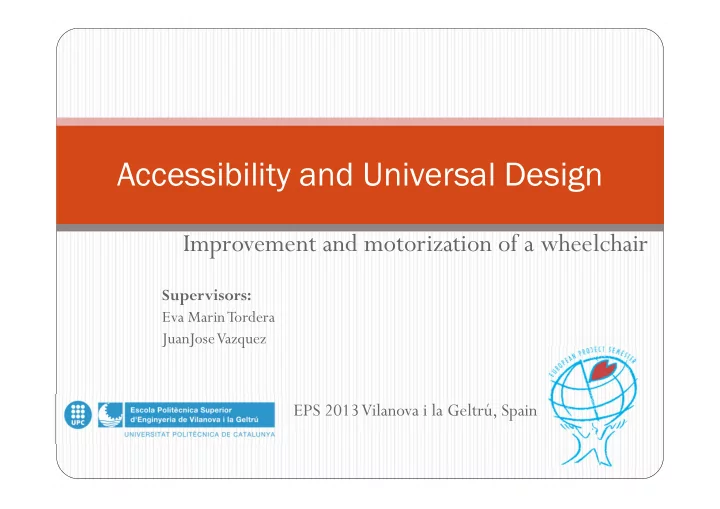

Accessibility and Universal Design Improvement and motorization of a wheelchair Supervisors: Eva Marin Tordera JuanJose Vazquez EPS 2013 Vilanova i la Geltrú, Spain
Project group members Charlotte Berthomieu, France Packaging Engineering Maurits Binnema, The Netherlands Human Technology Adina Marin, Romania Economic Engineering in the Mechanical Field Jan Stepputtis, Germany Business Informatics Ludwig Siegfrids, Finland Industrial Engineering and Management 2
Table of Contents Project tasks 1. Project progress 2. Background 3. Seat fixture 4. Handles 5. Steering system 6. Final product 7. Conclusion 8. 3
Project Task Improve the life of our client Provide higher autonomy Combine two wheelchairs 4
Project Progress Usability testing Construction Design Requirements analysis 5
Background: Client Nahuel ; 13 years old Dystonic, SpasticTetra Paresis In buggy wheelchair, strapped Muscle excercises with physiotherapist 6
Introduction movie client 7
Background: Clients Abilities Cognitive Physical No control Learning by body & facial time movements Acknowledge No speech differences Reacts to Little/No emotions strength 8
Buggy Wheelchair ‘ EASys ’ from Thomashilfen Seating construction is used Ergonomic benefit 9
Electric Wheelchair ‘ Power Picco ’ from Meyra Bottom part is used Stability benefit 10
Requirements Company • Realistic Product; Meets standards • Indoor usage Client • Fits user’s capabilities • Contributes to social and physiological al benefits Supervisor • Documentation • Effective teamwork • Low budget 11
Project Overview Universal Seating Adjustment Handles Steering System 12
Why a new Seat Fixture System? Problem • Combine chassis of electric wheelchair and seat • Keep each advantages How to solve it? • Designing different solutions for fixing the seat • Evaluating the convenience 13
Design: Universal Seat Fixture Universal Stable Secure 14
Project Overview Universal Seating Adjustment Handles Steering System 15
Why adjust the Handles? Problem • The seat covers the fixing place • Handles are too short for the pusher How to solve it? • Designing a new solution • Enlargement and addition of a steel block to move the fixing place 16
Design: Handles 17
Project Overview Universal Seating Adjustment Handles Steering System 18
Why a new Steering System? Problem • Actual solution not accessible • Not enough grip in hands How to solve it? • Research on steering systems • Comparing steering approaches • Evaluation of convenience for the client 19
Which Steering Systems are on the market? Joystick Chin Sip-n-Puff Head Voice Tongue Eye Gaze Brain 20
Which System meets the requirements of the client? 21
Which Steering System is the most convenient? Steering Systems 10 Chin 8 6 4 Head 2 Brain 0 -2 Sip-n-Puff Eye-Gaze -4 Joystick Voice -6 Tongue 22
Why Chin Control? - + Less space for head Safe system movements Less Short Not integrated in communication technical develop- system barriers ment time Intuitive steering 23
Design: Steering System Accessible Adjustable Economical Convenient 24
From Joystick to Chin Control 25
Final product 26
Usability & user interaction 27
Usability for the client - + Quick Still needs understanding help to steer Easy to learn Improve his new Easy capabilities interaction with the others 28
Wheelchair carriage - + Steering System can Does not be fold unmounted Easy Heavy transport of the buggy 29
Costs Estimated Project Costs 300 € 250 € 200 € Costs in € 150 € 100 € 50 € 0 € Pushing Steering Seating system Total handles System Materials 13 € 6 € 28 € 47 € Human labour 35 € 65 € 120 € 220 € 30
Conclusion Develop a psychological Challenging benefit Project Opportunity to have autonomy Nahuel will feel happier about the interaction with others 31
Future work Last adjustments Implementation of the steering of a safety system system 32
Thank you for your attention!
Recommend
More recommend